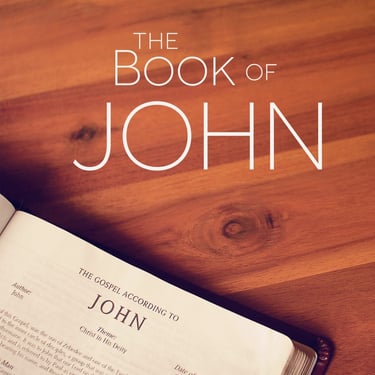

The Gospel of John, A Journey of Faith and Divine Love
The Gospel of John is one of the most profound books in the Bible. Written by the Apostle John, it stands apart from the Synoptic Gospels (Matthew, Mark, and Luke) with its unique focus on Jesus' divine nature and His mission to reveal God's love to humanity. John’s Gospel invites readers to deepen their faith, offering a profound portrayal of Jesus as the eternal Son of God and Savior of the world.
Structure and Themes of John’s Gospel
The Gospel of John can be divided into four primary sections:
Prologue (John 1:1-18): Introducing Jesus as the eternal Word of God.
The Book of Signs (John 1:19-12:50): Highlighting seven miraculous signs that reveal Jesus’ divine authority.
The Book of Glory (John 13:1-20:31): Focusing on Jesus’ death, resurrection, and glorification.
Epilogue (John 21): Affirming Jesus' mission through post-resurrection appearances.
Each section unfolds deep theological truths about Jesus’ identity and purpose.
Prologue: Jesus as the Word (John 1:1-18)
The opening verses of John are some of the most poetic and profound in Scripture:
"In the beginning was the Word, and the Word was with God, and the Word was God." (John 1:1, NIV)
Here, John declares Jesus as the "Word" (Logos) who existed eternally with God and is God Himself. This introduction establishes Jesus as Creator, life-giver, and the Light of the world.
John 1:14 captures the heart of the Gospel:
"The Word became flesh and made his dwelling among us. We have seen his glory, the glory of the one and only Son, who came from the Father, full of grace and truth."
Lesson: Jesus is fully God and fully human, embodying grace and truth. As believers, this challenges us to trust in His divinity and embrace His transformative grace.
The Book of Signs: Miracles and Belief
This section highlights seven miracles, or “signs,” each pointing to Jesus’ divine nature and mission:
Turning Water into Wine (John 2:1-11)
Jesus’ first miracle at a wedding in Cana demonstrates His power to transform and bring joy.“What Jesus did here in Cana of Galilee was the first of the signs through which he revealed his glory; and his disciples believed in him.” (John 2:11)
Healing the Official’s Son (John 4:46-54)
Jesus heals a dying boy from a distance, showing the power of faith.
Lesson: Faith doesn’t require physical evidence—trusting Jesus' word is enough.Healing the Paralyzed Man (John 5:1-15)
Jesus heals a man who had been disabled for 38 years, emphasizing His authority over human limitations."Do you want to get well?" (John 5:6) challenges us to take steps of faith toward healing.
Feeding the 5,000 (John 6:1-14)
By multiplying loaves and fish, Jesus reveals Himself as the Bread of Life who satisfies spiritual hunger.“I am the bread of life. Whoever comes to me will never go hungry.” (John 6:35)
Walking on Water (John 6:16-21)
Jesus calms His disciples’ fears by walking on water, demonstrating His power over creation.
Lesson: Jesus’ presence brings peace amidst life's storms.Healing the Man Born Blind (John 9:1-12)
By healing a man blind from birth, Jesus declares Himself the Light of the World.“As long as I am in the world, I am the light of the world.” (John 9:5)
Raising Lazarus from the Dead (John 11:1-44)
The resurrection of Lazarus foreshadows Jesus’ own resurrection, proving His power over death.“I am the resurrection and the life. The one who believes in me will live, even though they die.” (John 11:25)
Central Lesson: These signs invite us to believe in Jesus as the Messiah and find eternal life in Him (John 20:31).
The Book of Glory: The Passion and Resurrection
The Gospel’s second half shifts focus to Jesus’ final days, including His teaching, crucifixion, and resurrection.
The Upper Room Discourse (John 13-17)
In His farewell teachings, Jesus models servanthood by washing the disciples’ feet (John 13:1-17) and gives the "new commandment":
"Love one another. As I have loved you, so you must love one another." (John 13:34)
He promises the Holy Spirit as a Comforter and guide (John 14:16-17) and emphasizes abiding in Him:
"I am the vine; you are the branches. If you remain in me and I in you, you will bear much fruit." (John 15:5)
Lesson: Abiding in Christ through prayer, obedience, and love leads to fruitful living.
The Passion and Crucifixion (John 18-19)
Jesus’ arrest, trial, and crucifixion demonstrate His obedience to the Father’s will and His love for humanity:
"It is finished." (John 19:30) marks the completion of His mission to redeem humanity.
Lesson: Jesus’ sacrifice calls us to surrender our lives in gratitude and faith.
The Resurrection (John 20)
The empty tomb and Jesus’ post-resurrection appearances affirm His victory over sin and death. His words to Thomas resonate deeply:
"Blessed are those who have not seen and yet have believed." (John 20:29)
Lesson: The resurrection empowers believers to live with hope, knowing death is defeated.
Epilogue: Jesus’ Post-Resurrection Ministry (John 21)
In the final chapter, Jesus restores Peter, who had denied Him three times. His question, "Do you love me?" (John 21:15-17), underscores the importance of love and commitment in following Christ.
Lesson: Jesus restores and commissions us despite our failures, calling us to feed His sheep—serve others in His name.
Key Themes and Lessons from John
Jesus as the Son of God
John's Gospel emphasizes Jesus' divine identity, as seen in His "I AM" statements:
"I am the Bread of Life" (John 6:35)
"I am the Light of the World" (John 8:12)
"I am the Good Shepherd" (John 10:11)
"I am the Way, the Truth, and the Life" (John 14:6)
These declarations affirm Jesus as the source of spiritual nourishment, guidance, and salvation.
Lesson: Recognizing Jesus as the Son of God leads to eternal life (John 3:16).
The Importance of Faith
Faith is a central theme, with John repeatedly calling readers to believe in Jesus:
"But these are written that you may believe that Jesus is the Messiah, the Son of God, and that by believing you may have life in his name." (John 20:31)
From Nicodemus (John 3) to the Samaritan woman (John 4), John portrays how faith transforms lives.
Lesson: Faith is not just intellectual assent but trusting Jesus as Savior and Lord.
God’s Love for Humanity
John 3:16 encapsulates the Gospel’s message:
"For God so loved the world that he gave his one and only Son, that whoever believes in him shall not perish but have eternal life."
God’s love is self-giving and unconditional, inviting all to receive His gift of salvation.
Lesson: As recipients of divine love, we are called to love others (John 13:34-35).
Eternal Life Through Jesus
John assures readers that eternal life begins the moment they believe in Jesus:
"Whoever hears my word and believes him who sent me has eternal life and will not be judged but has crossed over from death to life." (John 5:24)
Lesson: Eternal life is not just a future promise but a present reality of living in a relationship with God.
The Gospel of John in Our Lives
The Gospel of John is a masterpiece of divine revelation, inviting every reader to encounter Jesus personally. Through its profound theology, miraculous signs, and call to faith, John teaches us to trust in Jesus as the eternal Word, the Lamb of God, and the resurrected Lord.
By believing in Him, we experience the fullness of life—peace, purpose, and the assurance of eternal life. As we reflect on John’s Gospel, may we embrace its central message:
"Jesus performed many other signs in the presence of his disciples, which are not recorded in this book. But these are written that you may believe that Jesus is the Messiah, the Son of God and that you may have life in his name by believing." (John 20:30-31)
This timeless invitation remains the heart of the Gospel—believe in Jesus and live abundantly in His love and grace.
